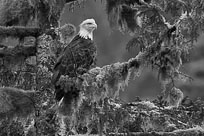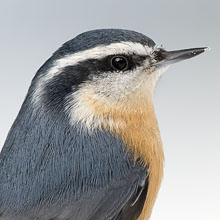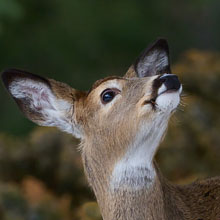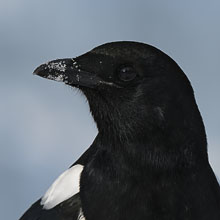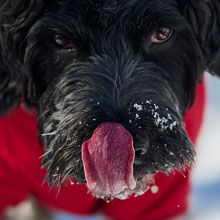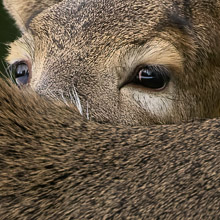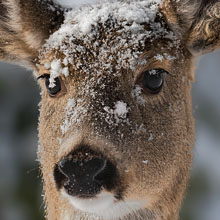Availability: Undetermined - Enquiries?
In the Field
Z 7II Testing - White-Tailed Doe With Snow. Findlay Creek Region (East Kootenays), British Columbia, Canada. December 26, 2020.
This is a further installment on my experiences with shooting wildlife using the Nikon Z 7II. This portrait-style shot of a snowy White-tailed doe nicely illustrates why I'm not yet a believer in the usefulness of animal eye-detection AF systems.
An absolute truism in wildlife photography is that if your subject's eye is visible, it better be absolutely in focus. I have no disagreement with the importance of having an animal's eye in focus in a wildlife shot. However, this "the eye must be sharp" dictum has somehow gradually morphed into something similar...but definitely NOT identical - that you should always focus on your subject's eye (which, for the record, is something I definitely do NOT agree with). And, in the competitive world of camera design, this derived idea has resulted in thinking along the lines of "Hey...because everyone knows that it's critical that the eye is in focus, let's design AF systems so they recognize and lock on the eye...that ought to sell us a bunch of cameras!"
Now there are certainly instances where focusing on the eye works. I can think of several species where an eye-detect system will work a lot of the time and produce images that work - the list would include humans, virtually all owl species, certainly most non-human primates, some pug-faced dogs, and often with both domestic and wild cats. What do all these species have in common? Flat faces. Which means that unless you are shooting a portrait with a lens like a NOCT 58mm f0.95 at f0.95, odds are your eyes and nose and mouth are all on the same or very similar focal plane.
BUT, if you are a wildlife photographer the majority or your subjects are NOT flat-faced - they have long snouts and their nose and eyes are certainly not particularly close together and, depending the distance to them, the focal length of lens you're using, and your aperture, odds are they AREN'T on the same focal plane. Think about the facial morphology of all members of the deer family, all canids, most rodents including squirrels and chipmunks, all North American bears, and the list goes on. As a matter of fact, just check out the image above - this doe's nose pad (complete with its fine hairs) are definitely NOT on the same focal plane as its eyes with the lens I captured this image with.
Now perhaps I'm unusual or an outlier, but when I shoot a shot like this one I want fine detail showing from the tip of the nose to the eyes and sometimes even slightly beyond. And, I want the background softened as much as practical, which means going with a relatively wide aperture. The net result is that if I focus on the eye of the doe there is little chance that the nose pad will be in sharp focus. Odds are when I'm shooting a shot like this I'm using at least a moderately long telephoto lens (in this case it was a Nikkor 500mm f5.6E PF) and reasonably close to my subject, which further limits my DoF. And, lenses like this also happen to have a DoF that is pretty equally distributed in front of and behind the focal point.
So, an eye detect AF system will lock on the eye here and produce a spectacularly sharp eye, but a soft and out-of-focus nose pad. (As an aside, Nikon's animal eye detect system on the Z 6II and Z 7II does work fine on wildlife like this - before I turned it off it was locking on this doe's eye reliably and quickly). So, what do I do in situations like this? I focus on a spot half way between the nose pad and the eyes. And I use this exact technique when I am photographing portraits of bears, wolves, coyotes, squirrels, and more. Perhaps I don't know what I'm doing, but regardless of the species I am working with - and regardless of their distance from me - I almost never focus on the animal's eye. And, a big part of creating images that I am happy with involves finding alternate focus points on my subject that will distribute the DoF exactly the way I want (which means I am constantly thinking about exactly what I want in focus in the shot and what I want softer). And, to be blunt, the last damn thing I want is to be fighting my AF system when I want to focus in one very specific point and it wants to focus elsewhere! For me, probably the most critical part of an eye-detect AF system is something no manufacturer seems to be offering or promoting - the ability to turn it off (or fully override it) in a millisecond!
So, at least for me, having a camera with small, tightly spaced individual focus points, ergonomics allowing easy and rapid "toggling" of my selected focus point to exactly where I want it (like you find on the Nikon D6 and on the Nikon Z 7II, among other cameras), and extreme accuracy of the AF system is way more important than having the latest animal eye-detect technology.
Here's a larger version (2400 pixel) of this snow-doe:
• White-Tailed Doe With Snow: Download 2400 pixel image (JPEG: 1.6 MB)
ADDITIONAL NOTES:
1. This image - in all resolutions - is protected by copyright. I'm fine with personal uses of them (including use as desktop backgrounds or screensavers on your own computer), but unauthorized commercial use of the image is prohibited by law. Thanks in advance for respecting my copyright!
2. Like all photographs on this website, this image was captured following the strict ethical guidelines described in The Wildlife FIRST! Principles of Photographer Conduct. I encourage all wildlife photographers to always put the welfare of their subjects above the value of their photographs.
Behind the Camera
Z 7II Testing - White-Tailed Doe With Snow. Findlay Creek Region (East Kootenays), British Columbia, Canada. December 26, 2020.
Compressed RAW (NEF) 14-bit format; ISO 500.
Nikon Z 7II paired with Nikkor 500mm f5.6E PF super-telephoto lens. Hand-held. VR on and in Sport mode. Single Point AF area mode.
1/500s @ f7.1; -0.67 stop compensation from matrix-metered exposure setting.
At the Computer
Z 7II Testing - White-Tailed Doe With Snow. Findlay Creek Region (East Kootenays), British Columbia, Canada. December 26, 2020.
RAW Conversion to 16-bit PSD file (and JPEG files for web use), including all global and selective adjustments, using Phase One's Capture One Pro 21. Global adjustments limited to a tweak to the whites. Selective local adjustments performed using Capture One Pro's layers and masking tools. In this case selective adjustments were made on 8 separate layers and included one or more tweaks to levels, color balance, blacks, sharpness, and structure (it's a Capture One thing).
Photoshop modifications were limited to the insertion of the watermark and/or text.
Conservation
Z 7II Testing - White-Tailed Doe With Snow. Findlay Creek Region (East Kootenays), British Columbia, Canada. December 26, 2020.
Species Status in Canada*: This species is not designated as at risk.
White-tailed Deer (Odocoileus virginianus) are one of the most widely distributed mammals in North America - they can be found in virtually all of southern Canada and in most of the American states. While whitetails are common now, in the late 1800's they were in serious risk of extinction - their populations had been reduced from about 40 million (across North America) to under 500,000. The conservation effort to return whitetails to numbers sufficient for long-term survival was massive and included strict harvest regulations, intense management, reintroductions, and habitat protection. Today, most populations in the United States do not represent original stock and the distinction of most historical subspecies is uncertain.
Whitetails resemble Mule Deer quite closely, and the two species overlap in distribution in western North America. The two species tend to prefer different habitats, with whitetails occupying more heavily forested land and along river valley bottoms, while muleys tend to prefer uplands and montane areas. On rare occasions, the two species will interbreed. Occasionally the offspring are fertile, but in most cases they are sterile.
This whitetail fawn was photographed in the Columbia Valley of the East Kootenays. While this species is not currently considered at risk, many ecosystems within the Columbia Valley face development pressure, including pressure from logging operations.
*as determined by COSEWIC: The Committee on the Status of Endangered Wildlife in Canada










